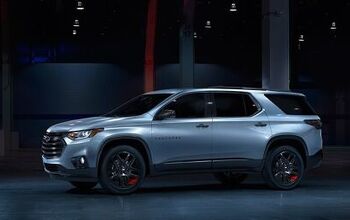Why Front-Wheel-Drive Cars Are More Efficient

Front-wheel drive dominates today’s automotive landscape, powering everything from subcompact hatchbacks to full-size SUVs. However, it wasn’t always this way. Back in the day rear-wheel drive was king, but over the last 30-odd years carmakers have made a dramatic shift from back to front. Why the flip-flop? No, they weren’t impersonating John Kerry; in reality, they didn’t have a choice.
Of course this layout has its disadvantages, too. And probably the biggest one is efficiency, though not necessarily what you’re thinking. Yes, improved fuel economy was arguably the No. 1 reason for the transition to front-wheel drive over the last three decades, but that’s not the only reason automakers switched things around.
“The fuel efficiency [benefit] is ethereal” said Jim Hall, Managing Director of 2953 Analytics because “It’s primarily about packaging.” He said front-wheel drive allows a company to make cars smaller and lighter. This is why they’re more efficient than rear-wheel drive ones, not necessarily because rear-wheel drive is hugely more wasteful, though it’s generally a bit heavier.
“The incremental weight tends to be the incremental weight of the prop shaft” said Hall, noting that it also takes extra power to turn a long, heavy driveshaft that routs torque to the back-end.
Reiterating his earlier point, Hall said “Front-wheel drive is all about packaging.” He explained that in a typical front-engine, rear-drive vehicle the transmission tends to eat up a lot of interior volume and that becomes a big issue on small cars that have limited cabin space. This is why there are almost never any compact cars with rear-wheel drive. Also, rear-axle assemblies can gobble up precious trunk space, another downside in a small car.
“The big focus is improving engine technology, improving transmission technology and driveline technology” Barrett said. “Cylinder deactivation, direct injection, variable valve timing, the whole variety of engine technologies” are being used by automakers to improve fuel economy.
SEE ALSO: What’s the Best All-Wheel-Drive System for You?
Barrett said the least efficient part of a vehicle is the engine but “Transmission technology then becomes the second area of focus.” Automakers are aiming for 10 to 15 percent improvements in powerplant efficiency. Barrett said “We’re squeezing 2 or 3 percent gains out of our products” and that’s pretty impressive because with axles and differentials there’s not a whole lot to work with. Engines have many systems that can be optimized and improved but the driveline is pretty much just gears and bearings.
B
As touched upon earlier, rear drive is usually heavier. “Mass efficiency on front-wheel drive cars tends to be better” Hall said. The driveshaft, rear axle and associated structure all add mass and additional cost. Not surprisingly that extra expense makes rear-wheel drive more economically viable at the premium end of the market, which is part of the reason why many luxury vehicles use that drivetrain layout, plus it’s better from a handling standpoint.
But efficiency still matters, even with premium vehicles. Automakers and suppliers are working tirelessly to stretch every drop of fuel as far as possible, and AAM is doing some interesting things in this area.
“We supply the independent rear-drive axle for the Cadillac ATS” Barrett said. To make it as efficient as possible “We attacked it from every aspect.”
“Sounds simple at the high level” he said, but the devil really is in the details. For instance, AAM used a mix of bearings – both ball and high-efficiency tapered units – to cut friction. They laser welded the ring gear to the case inside the differential, which eliminated the need for bolts and saved more weight. This was particularly challenging because parts can distort from the heat of welding. Engineers also tinkered with the oil seals to reduce drag; they even examined the lubricant used inside the axle assembly. Barrett said “What are the additive packages in the lube to absolutely minimize the friction in the axle?” No stone went unturned; no part was ignored.
SEE ALSO: What is Motor Oil?
The end result of all this hard work is pretty impressive. “It’s the highest efficiency IRDA (independent rear-drive axle) on the market” Barrett said, meaning it tops competing systems used by Lexus and Mercedes-Benz. All told their efforts resulted in a 2 to 3 percent improvement in fuel economy. That works out to about .2 miles per gallon, which “at first glance doesn’t seem like a lot, but it’s HUGE” Barrett said.
Aside from the Cadillac ATS, AAM also supplies GM with rear-drive assemblies for the Chevrolet Camaro, both V6- and V8-powered models as well as the insanely quick ZL1.
With government regulators demanding ever-better fuel economy rear-wheel drive is under siege. You could argue it’s at risk of going extinct in mass-market vehicles, but if companies like AAM can continue refining the layout it will remain a viable option in the future.
GALLERY: Front-Wheel Drive vs. Rear-Wheel Drive
GALLERY: 2013 Cadillac ATS

Born and raised in metro Detroit, Craig was steeped in mechanics from childhood. He feels as much at home with a wrench or welding gun in his hand as he does behind the wheel or in front of a camera. Putting his Bachelor's Degree in Journalism to good use, he's always pumping out videos, reviews, and features for AutoGuide.com. When the workday is over, he can be found out driving his fully restored 1936 Ford V8 sedan. Craig has covered the automotive industry full time for more than 10 years and is a member of the Automotive Press Association (APA) and Midwest Automotive Media Association (MAMA).
More by Craig Cole




































Comments
Join the conversation
RWD vs FWD is a never-ending discussion. I've driven both RWD and FWD cars and can tell you that I find FWD cars to be easier to handle and safer to push to the limits. What I DON'T like about FWD is the weight unbalance and how the front tires get quickly wasted. Until they find out how to minimize understeer and make the front tires last longer, I think I prefer the FR layout and its better weight distribution.
What About Cars Like The Mr2? Its Basically Fwd Layout With The Engine And DrivE Wheels In The Back. Trade Off Would Be Space But My 88 Supercharged Mr2 Still Gets 30Mpg Combined, Better Then Alot Of Modern Ff Layouts.